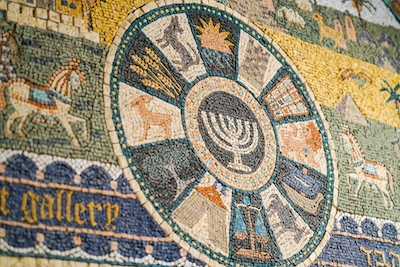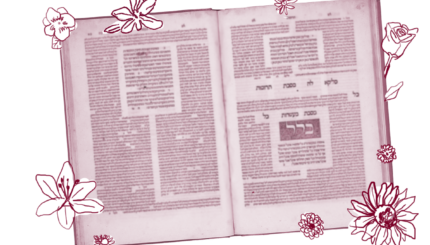The mishnah on Sanhedrin 56a, echoing both Noahide law (Genesis 9), as well as Leviticus 24 and 1 Kings 21, teaches that one who blasphemes God — one who curses God using the divine name — is sentenced to death. Trying a blasphemer is tricky, because in order for witnesses to give proper testimony — by repeating exactly what the blasphemer said — they may be guilty of the very same crime. So how does the court collect the necessary evidence?
When the judgment is over, they do not sentence him to death based on a euphemism. Rather, they remove all the people and interrogate the eldest of the witnesses, and say to him: “Say what you heard explicitly.” And he says. And the judges stand on their feet and make a tear in their clothing. And they do not stitch it together. And the second witness says: “I too heard as he did.” And the third says: “I too heard as he did.”
Initially, the witnesses describe what they heard using a euphemism. But then, to be sure the judges have no doubt about the exact words used, they remove the audience, ask the eldest witness to faithfully reproduce what was said, and then stand and tear their clothes, gestures of respect and mourning. This procedure is meant to collect unambiguous testimony while mitigating any damage that might be wrought with the use of the divine name in this context.
The Talmud today interrogates where the rabbis learn each component of this ritual, starting with the requirement that the judges stand:
From where do we derive that the judges must stand? Rabbi Yitzhak bar Ami says: From that which the verse states: “And Ehud came to him, and he was sitting by himself alone in his cool upper chamber. And Ehud said: I have a message from God (Elohim) to you. And he arose out of his seat” (Judges 3:20). And are these matters not kal va’homer? And if Eglon, king of Moab, who was a gentile and knew God only by a euphemism, stood, all the more so must a Jew stand if he hears the ineffable name.
In the Book of Judges, the Israelite judge Ehud infiltrates the court of the enemy Moabite King Eglon. Coming upon the king all alone, Ehud announces he has a message from God, whereupon the king stands and, now that he has a clear shot at the king’s abdomen, Ehud sinks a sword into him. According to Rabbi Ami bar Yitzhak, Ehud induced the king to stand by using the word Elohim — a name of God, though not God’s personal name. And, he further argues, if even a wicked Moabite king stands for an alternative name of God, then Jews — including the rabbinic judges of a trial — must stand for God’s personal name, the Tetragrammaton.
From where do we derive that the judges make a tear? From that which is written: “Then came Eliakim, son of Hilkiah, who was over the household, and Shebna the scribe, and Joah, son of Asaph, the recorder, to Hezekiah with torn garments, and they told him the rabshakeh’s statement” (2 Kings 18:37).
According to 2 Kings 18, while besieging the land of Israel, the Assyrian King Sennachrib sent officials, including one whose title was rabshakeh, to the court of the Israelite King Hezekiah to demand his surrender. In that meeting, the rabshakeh makes a loud public speech insisting that God has sent him to defeat the Israelites, and promising that the might of the Assyrians is greater than the might of Egypt or any of the nations that Assyria has already conquered. According to the Talmud, this speech is blasphemy, and the Israelite listeners responded appropriately by tearing their garments. Likewise, judges in court who hear testimony that includes the Tetragrammaton tear their garments.
From where do we derive that they do not stitch it back together? Rabbi Abbahu says: It is derived by a gezeirah shavah of tearing here and the tearing there. It is written here: “With torn garments,” and it is written there: “And Elisha saw it, and he cried: My father, my father, the chariots of Israel and its horsemen. And he saw him no more, and he grabbed hold of his clothes and tore them into two pieces.” (II Kings 2:12) From the meaning of that which is stated: “And tore them into two,” do I not know that they are pieces? And why must the verse state: “Pieces”? This teaches that they remain torn forever.
When Elisha saw the glory of Elijah’s ascendance to heaven on a fiery chariot, and realized that Elijah would never return to earth, he tore his clothing in two. Rabbi Abbahu insists that the repeated language of “he tore” in this verse indicates the garment was torn into two separate pieces and never repaired.
Today, with liberal democracy’s values of free speech and freedom of religion, the idea of executing someone for what they said about God seems very foreign. But for the rabbis, God’s holy name held unfathomable power. They feared that should someone wield that power arbitrarily, the community would find itself in untold peril.
Read all of Sanhedrin 60 on Sefaria.
This piece originally appeared in a My Jewish Learning Daf Yomi email newsletter sent on February 15, 2025. If you are interested in receiving the newsletter, sign up here.

Help us keep Jewish knowledge accessible to millions of people around the world.
Your donation to My Jewish Learning fuels endless journeys of Jewish discovery. With your help, My Jewish Learning can continue to provide nonstop opportunities for learning, connection and growth.



